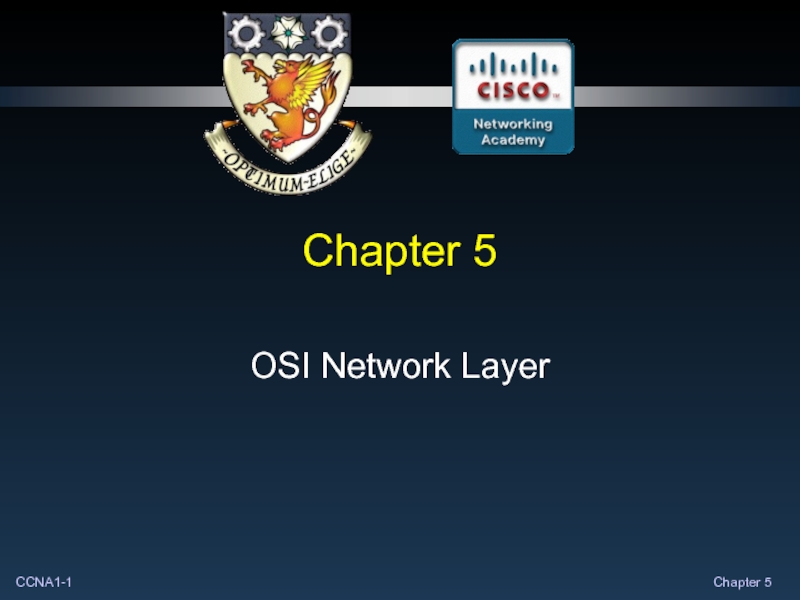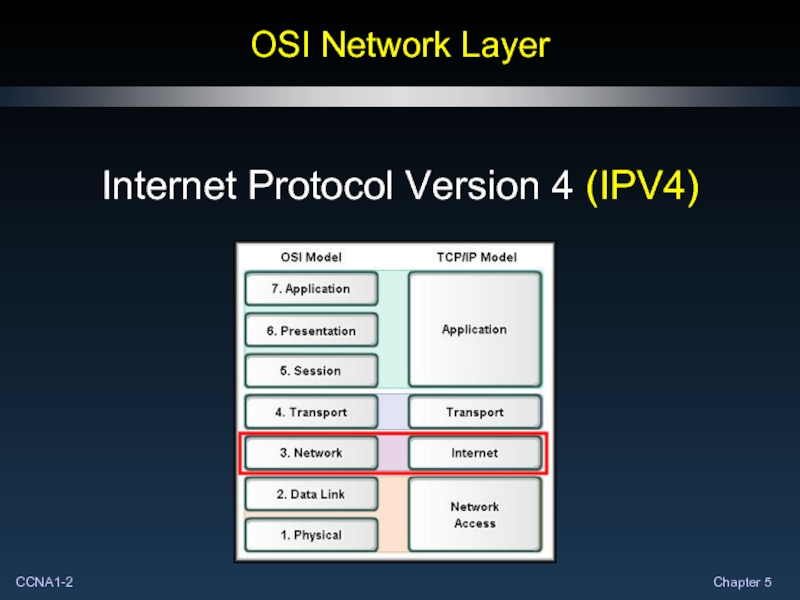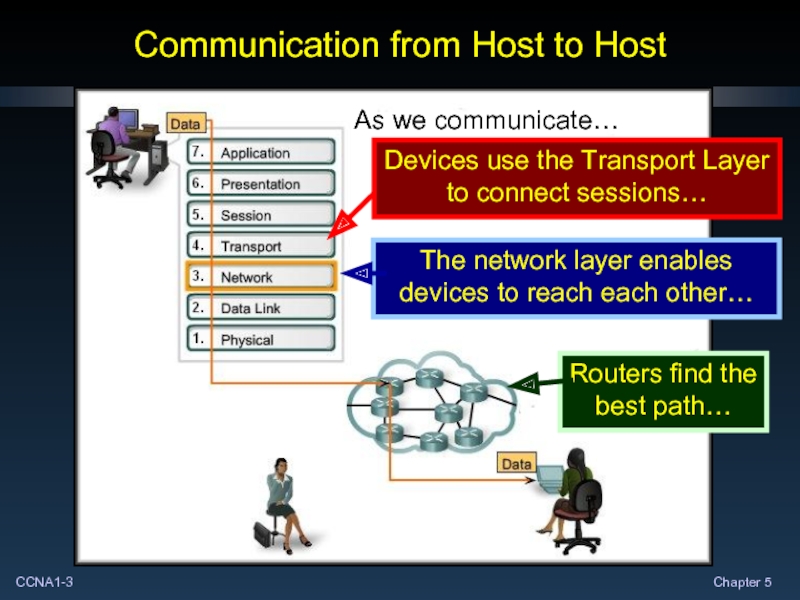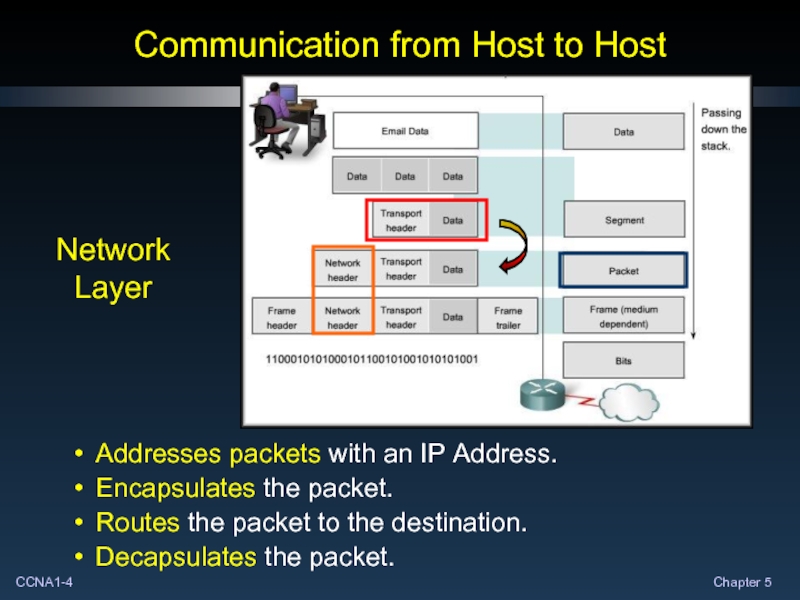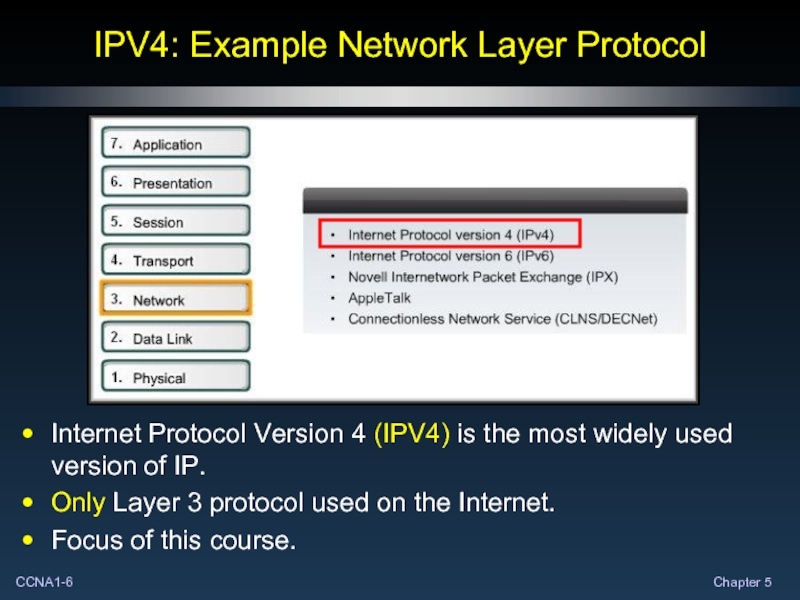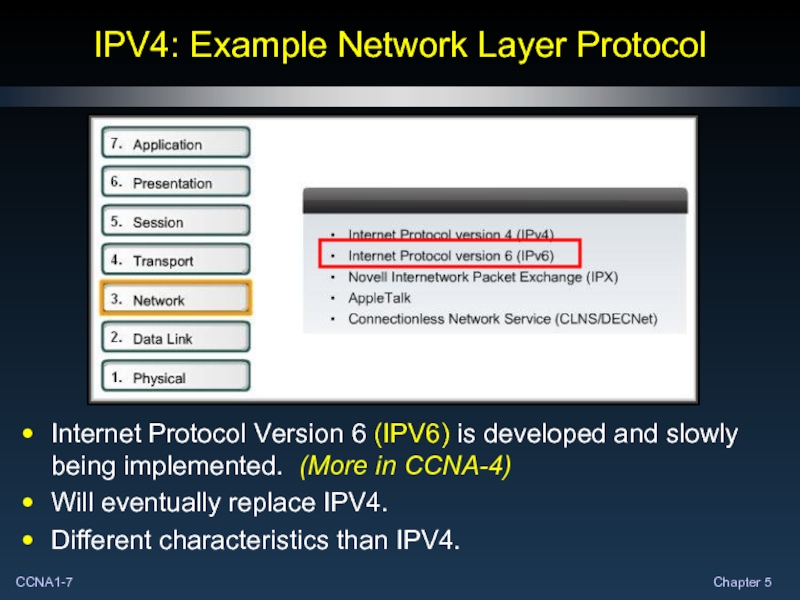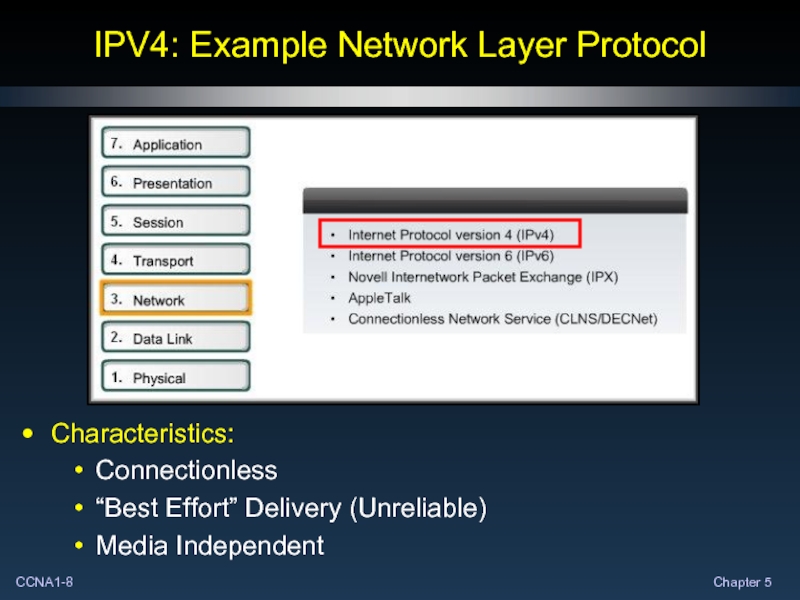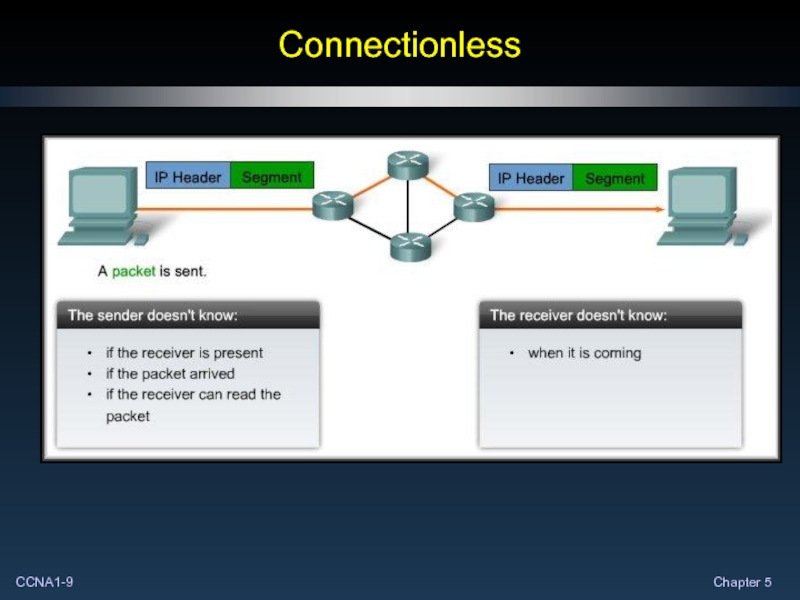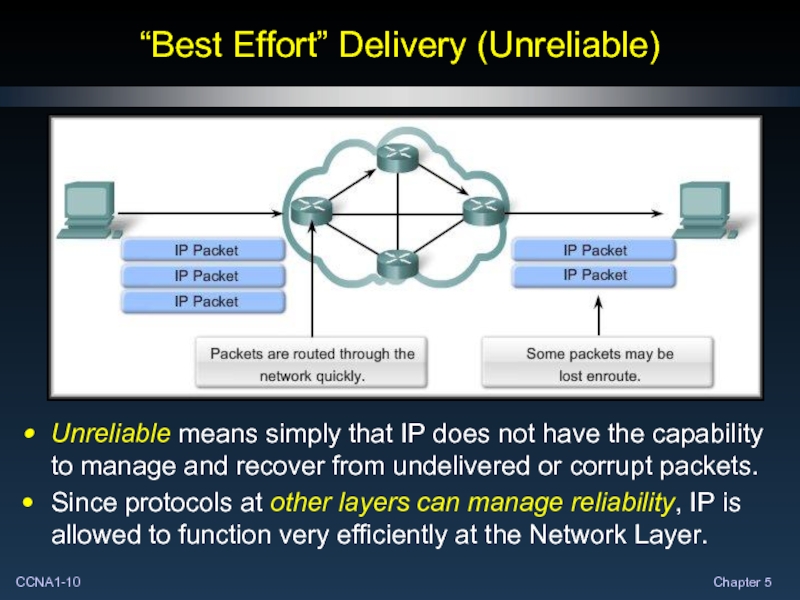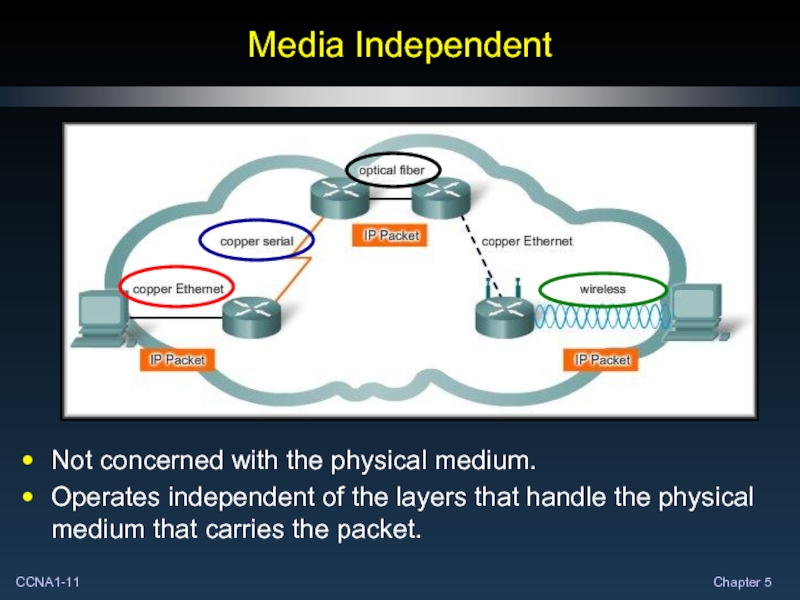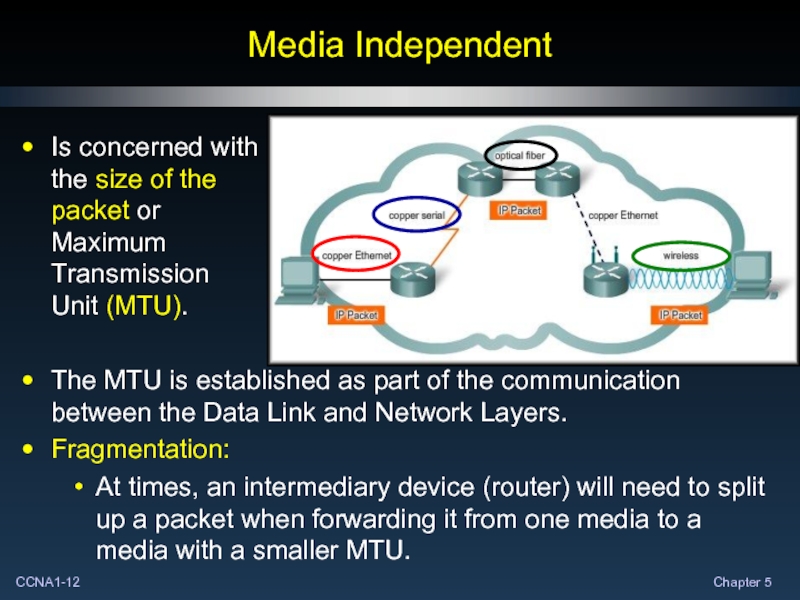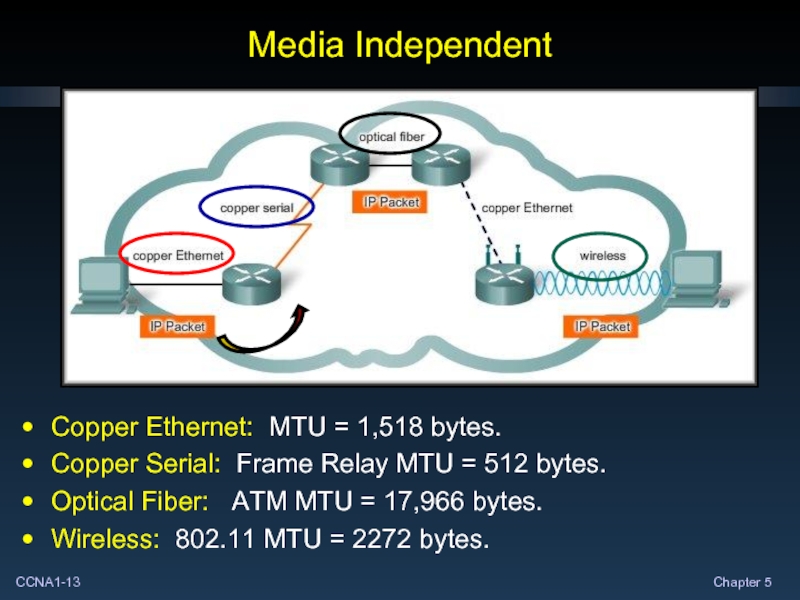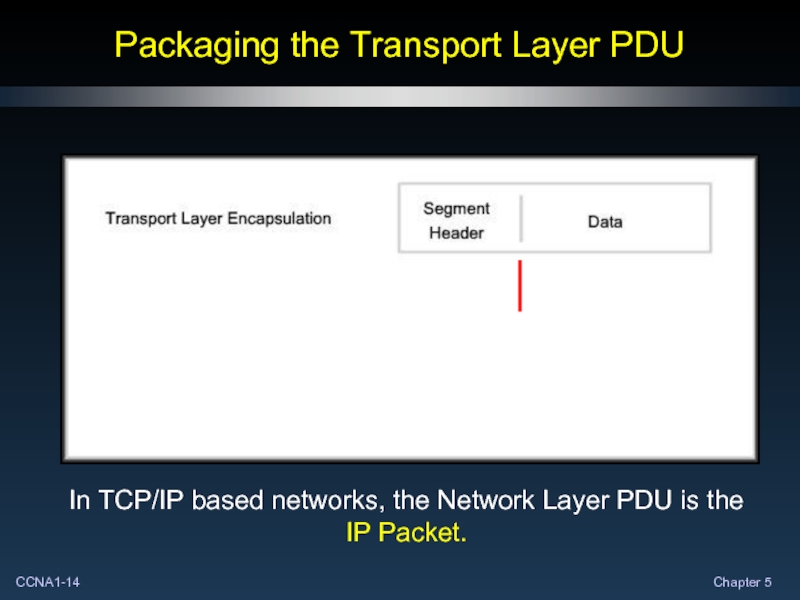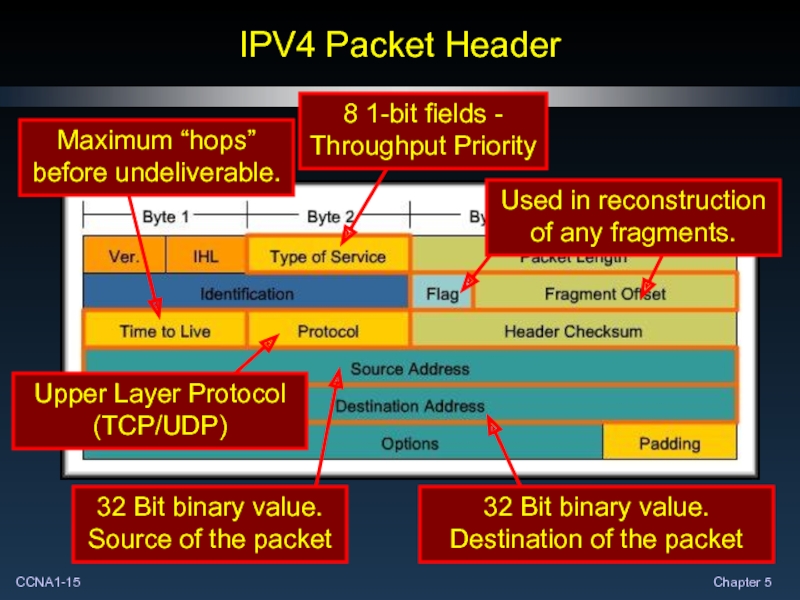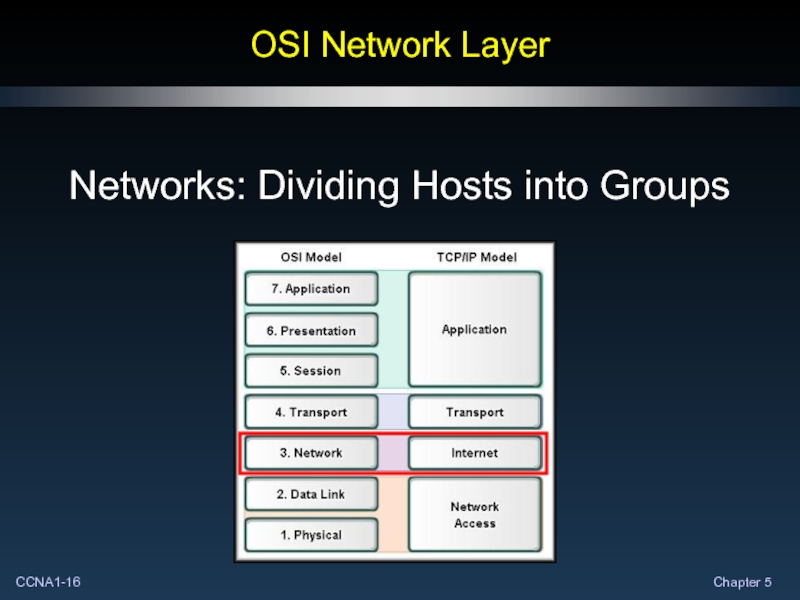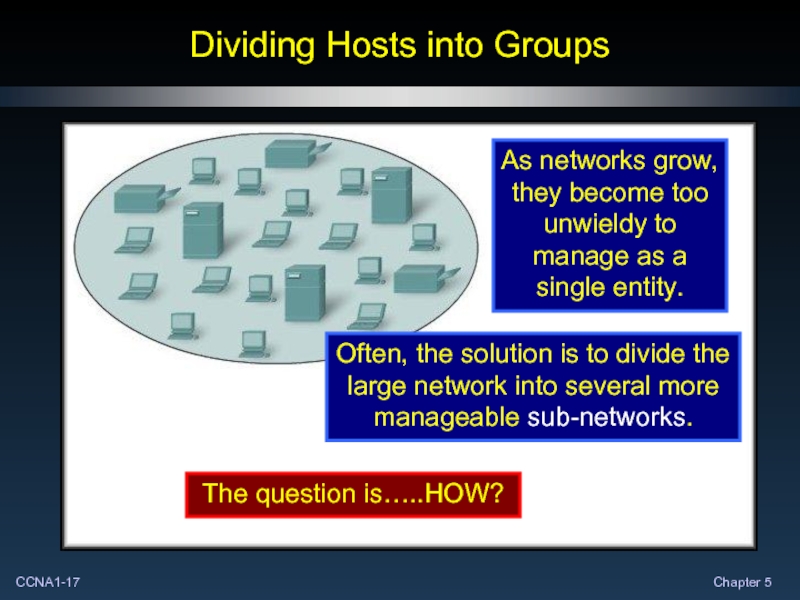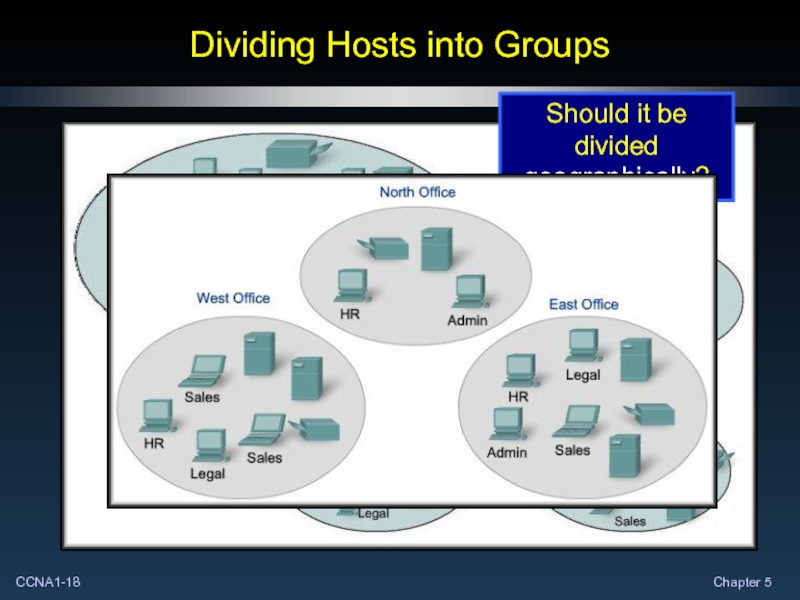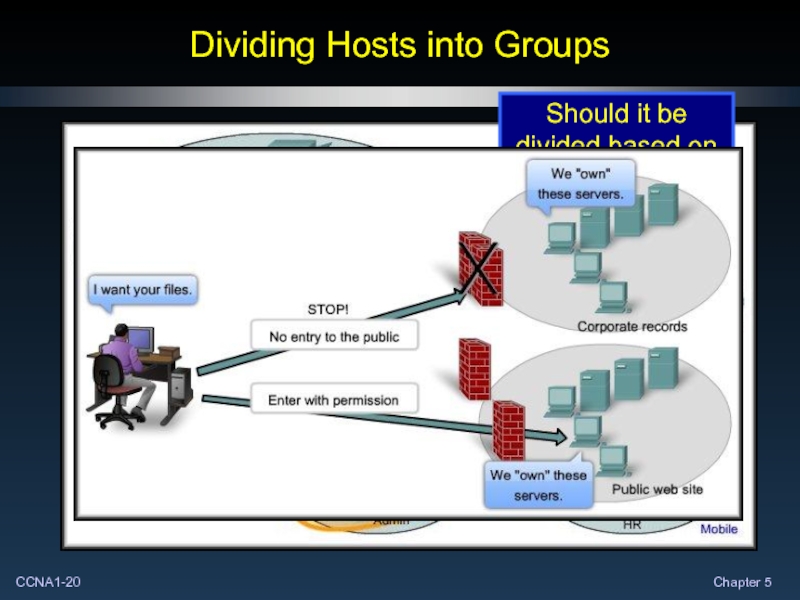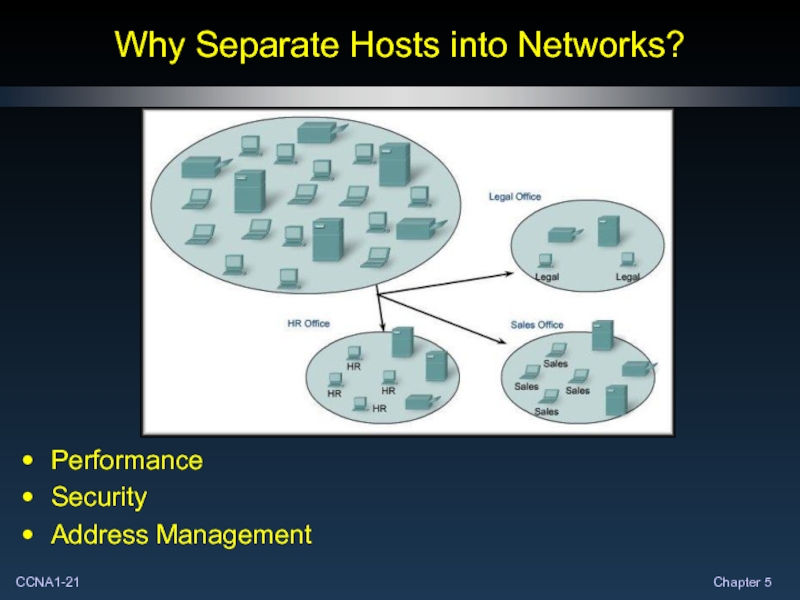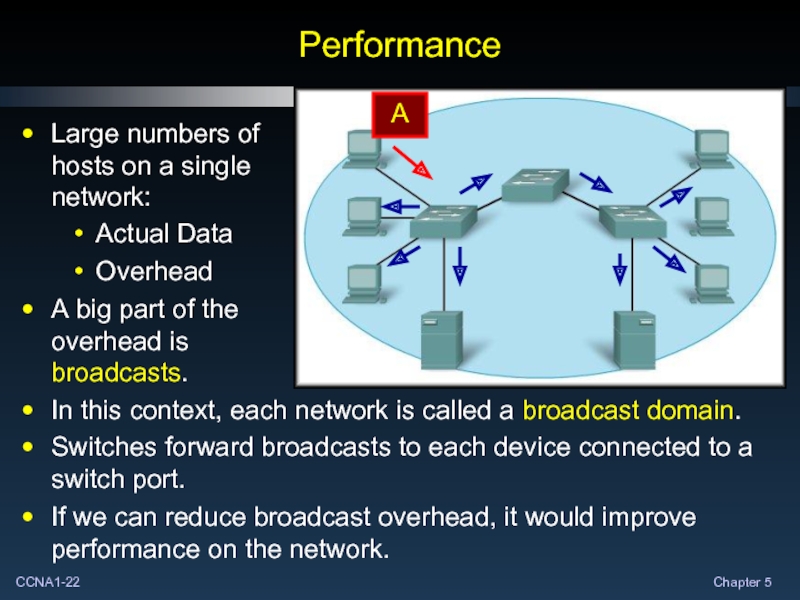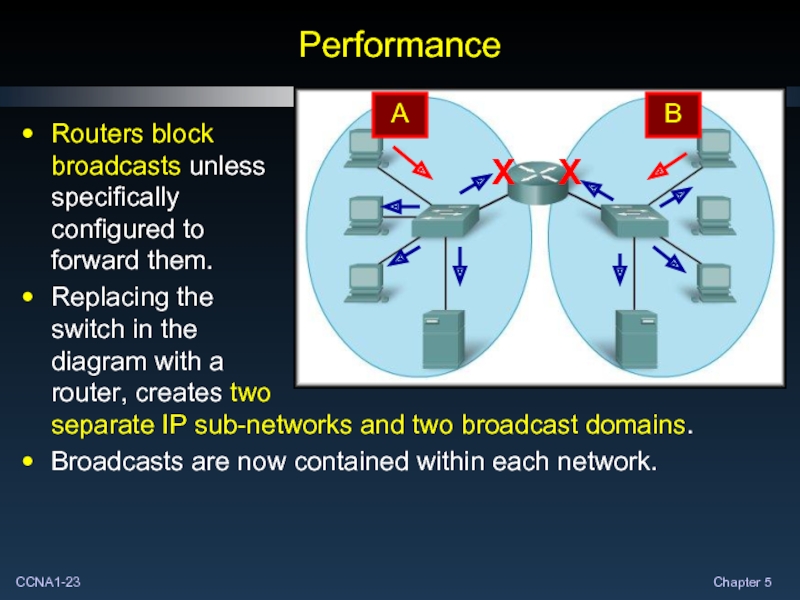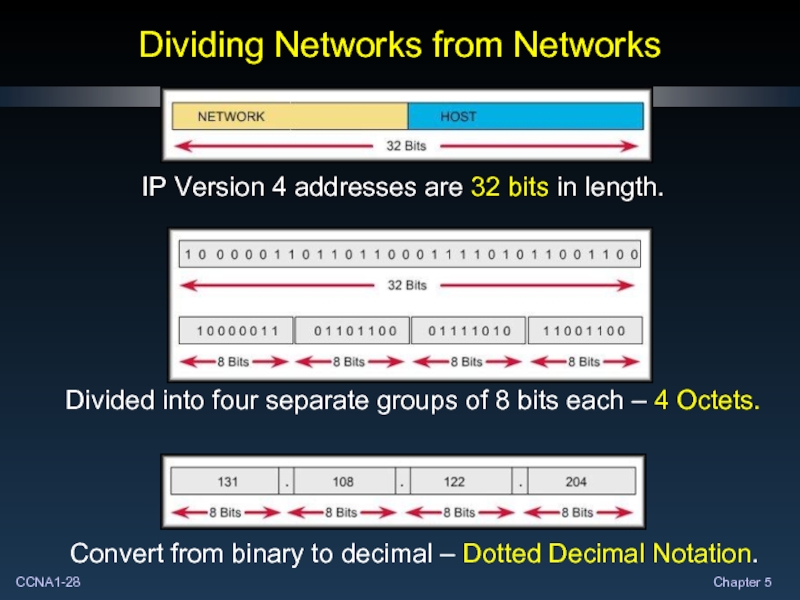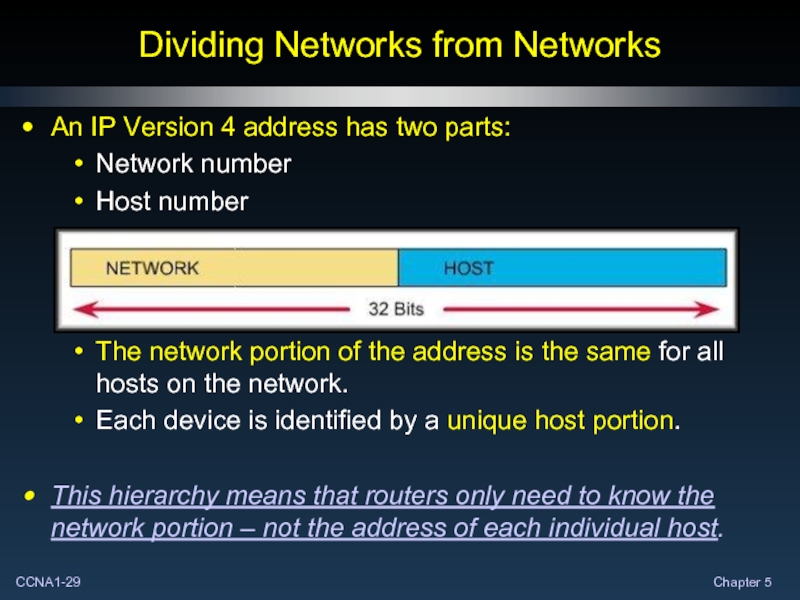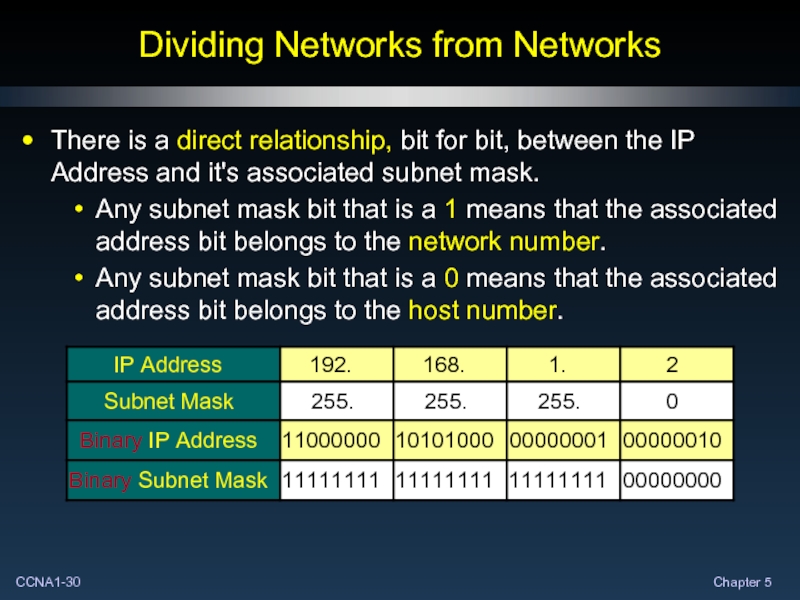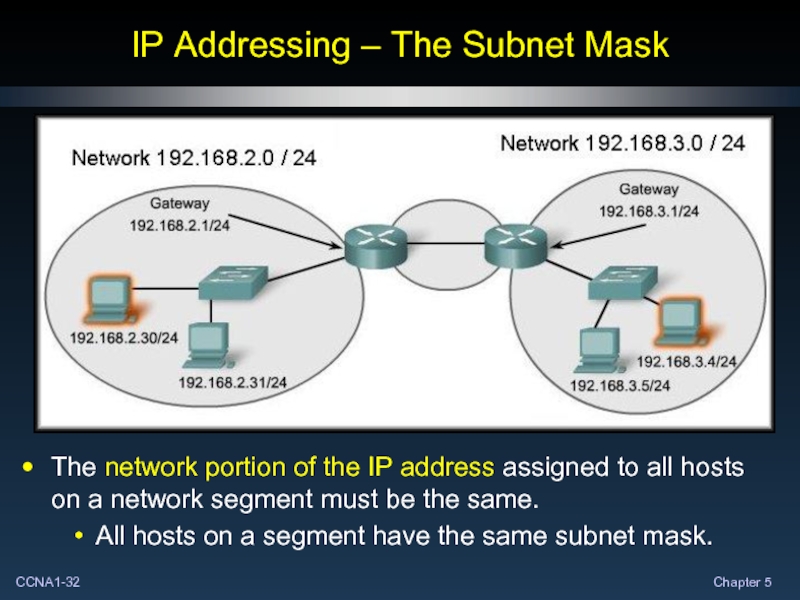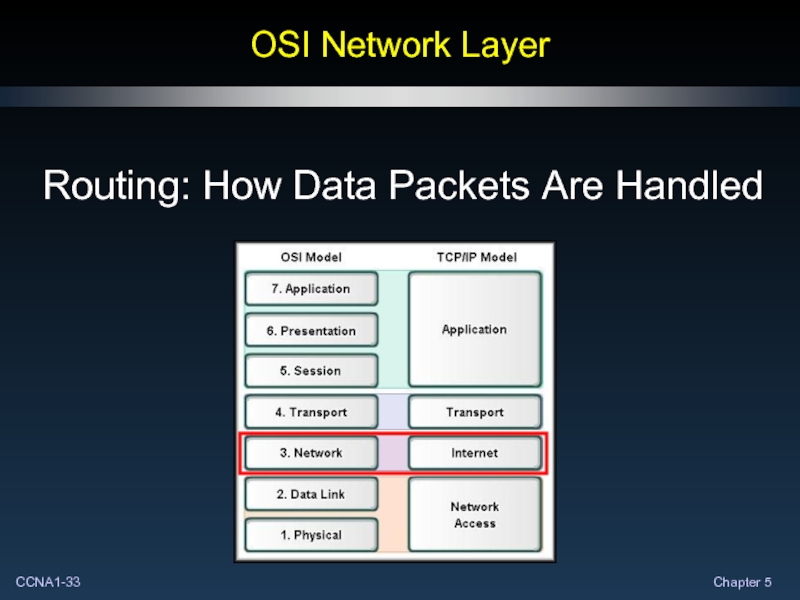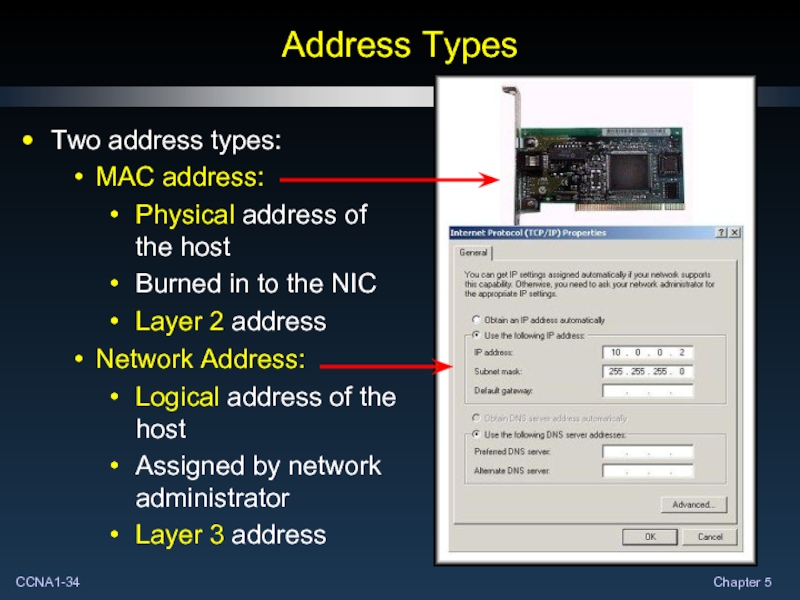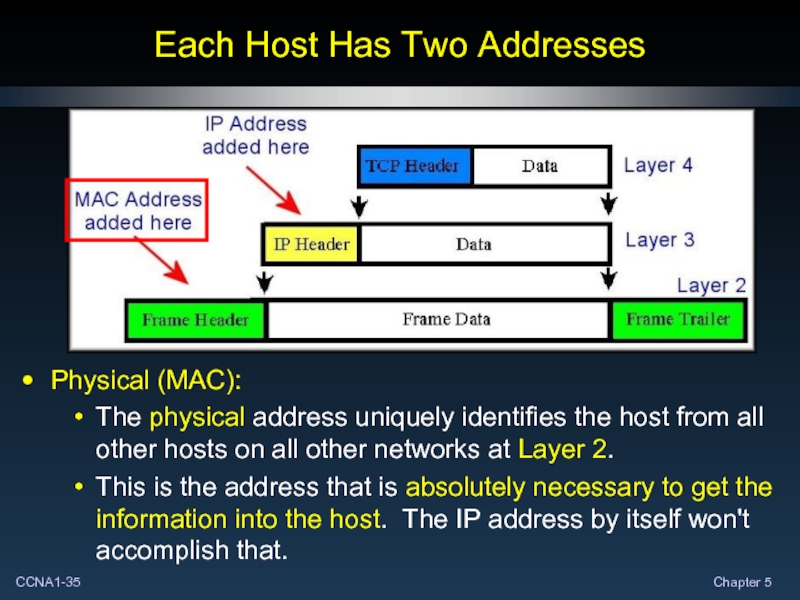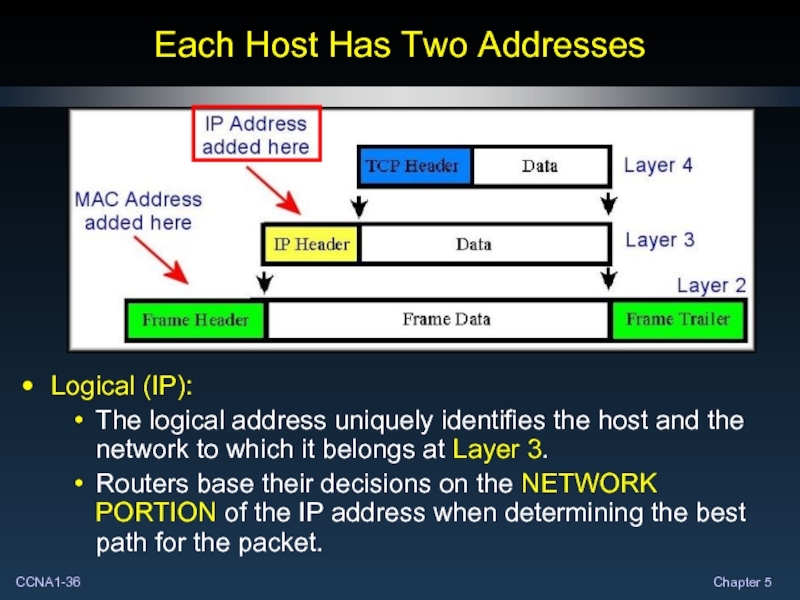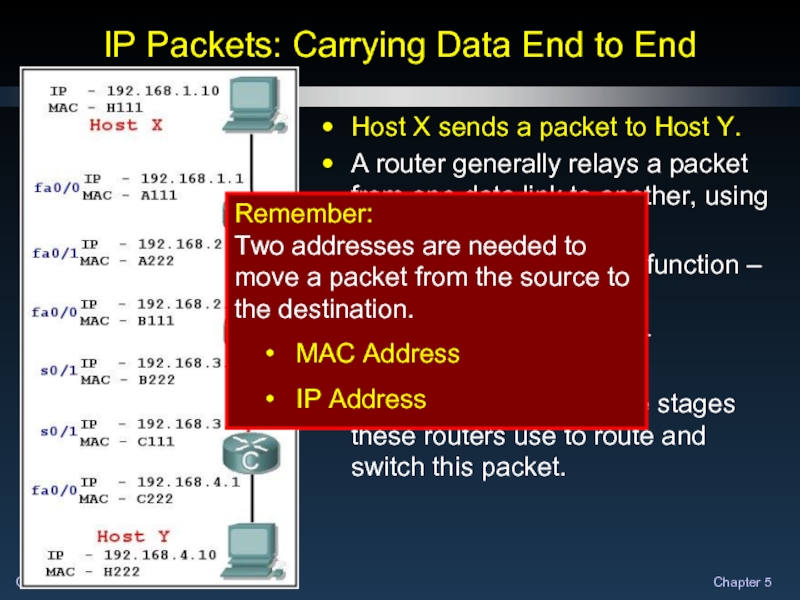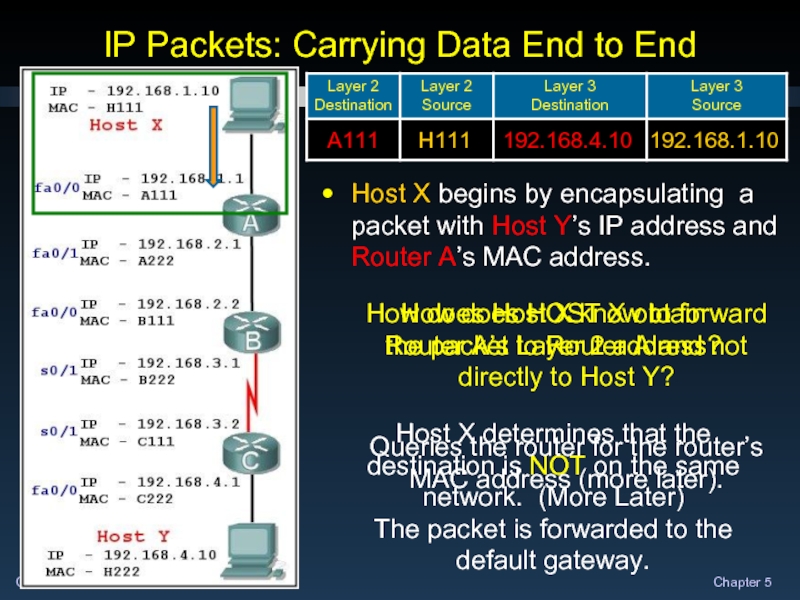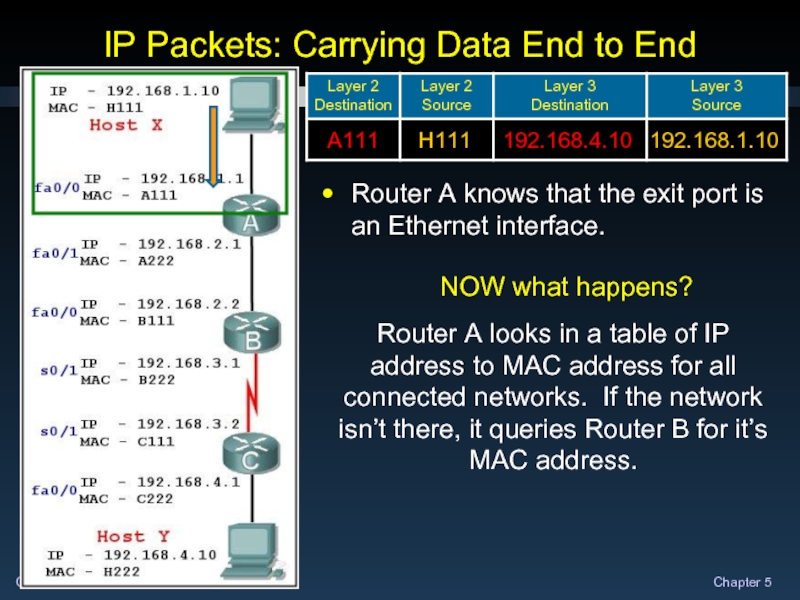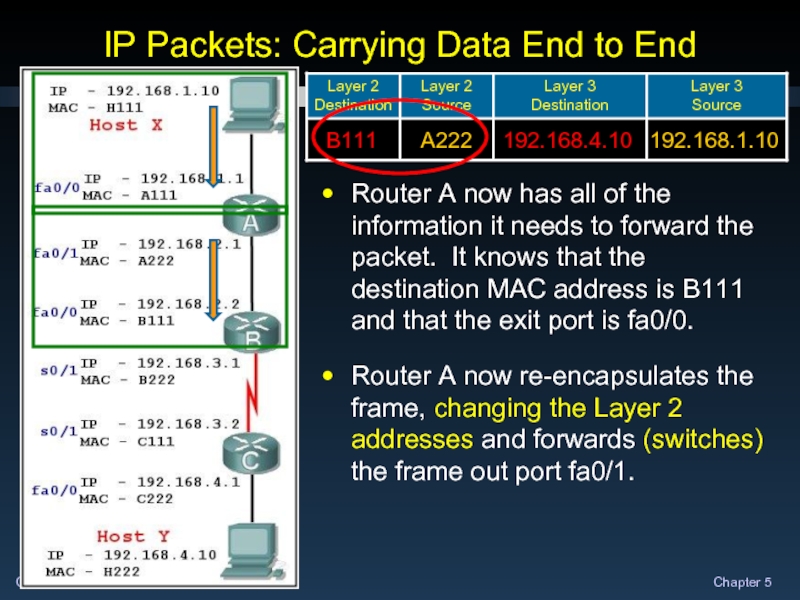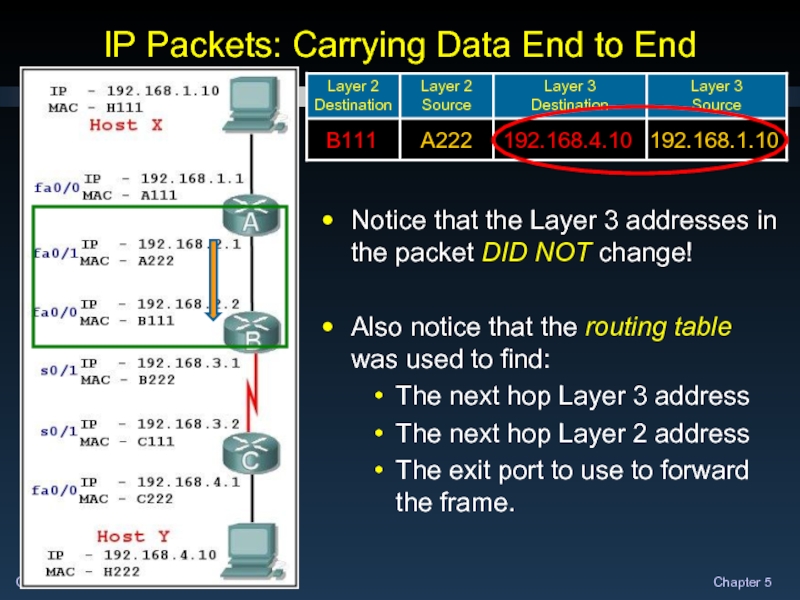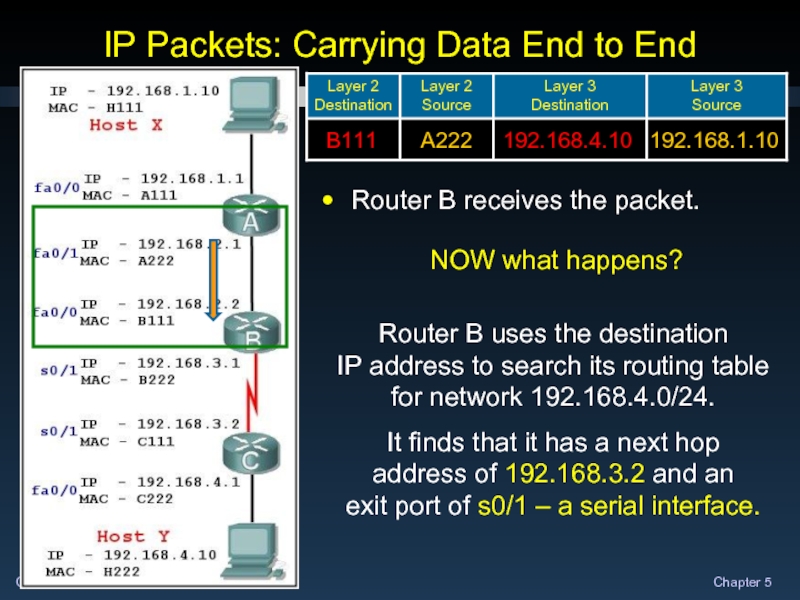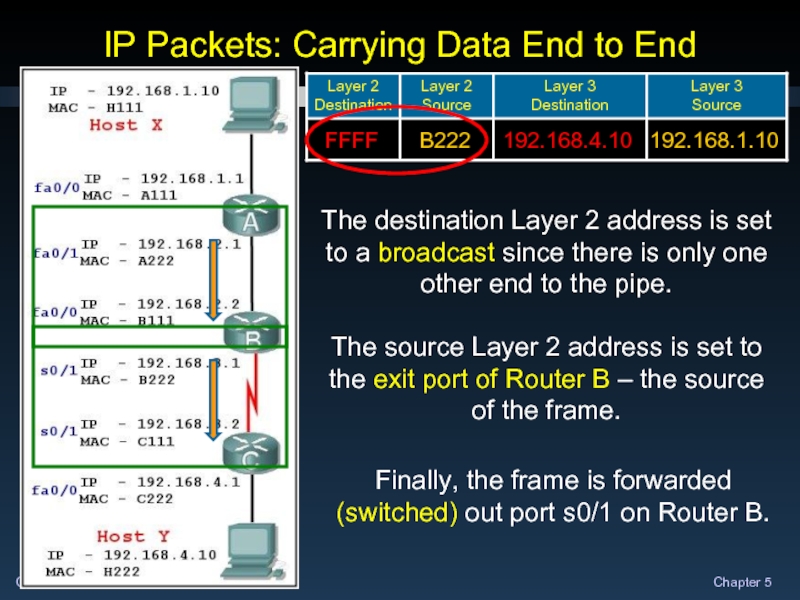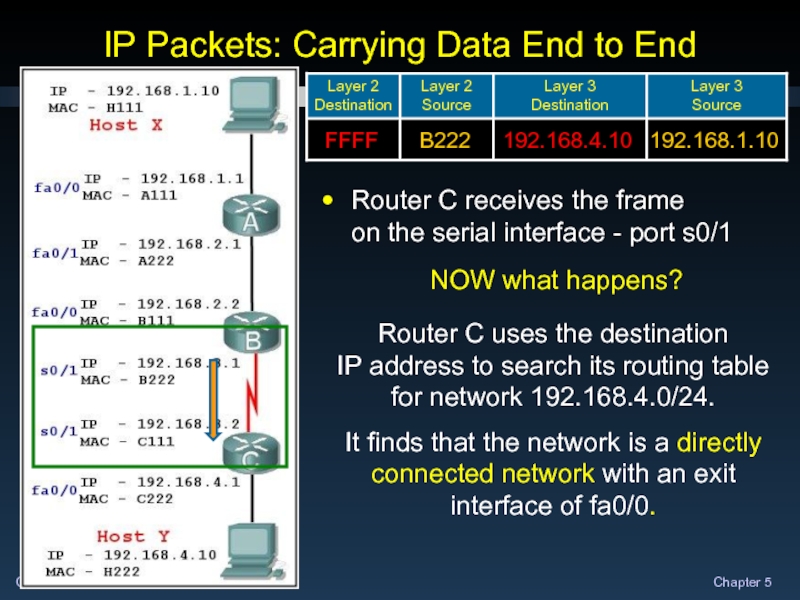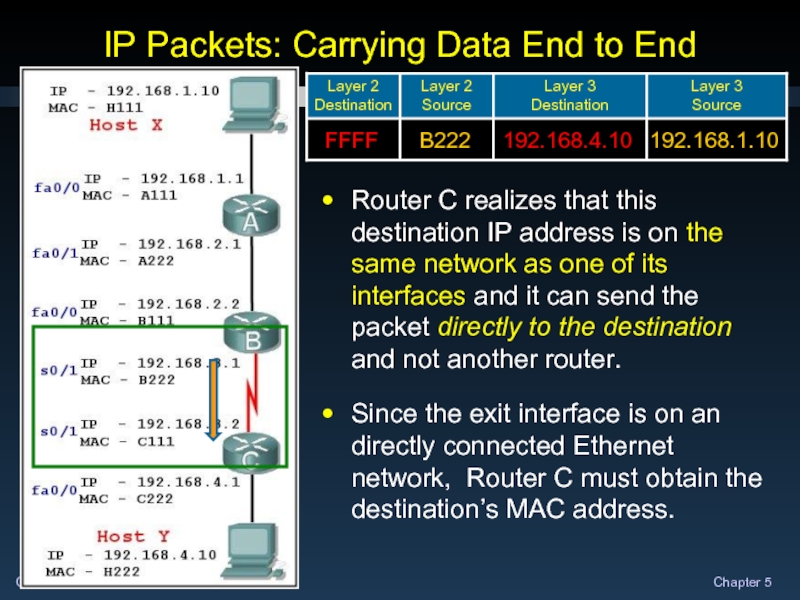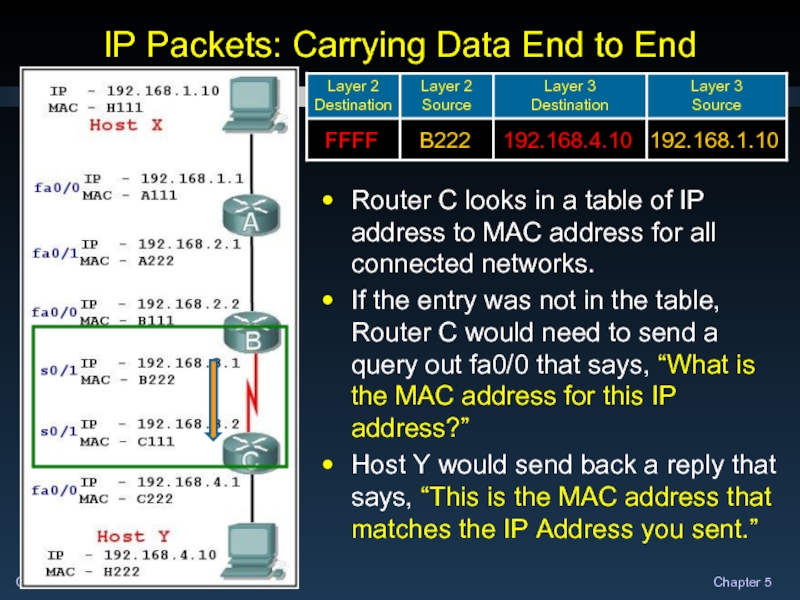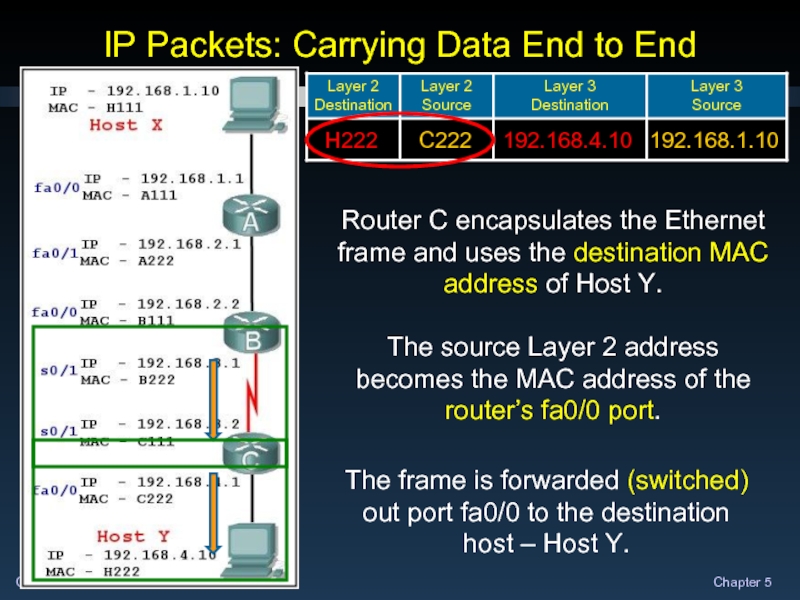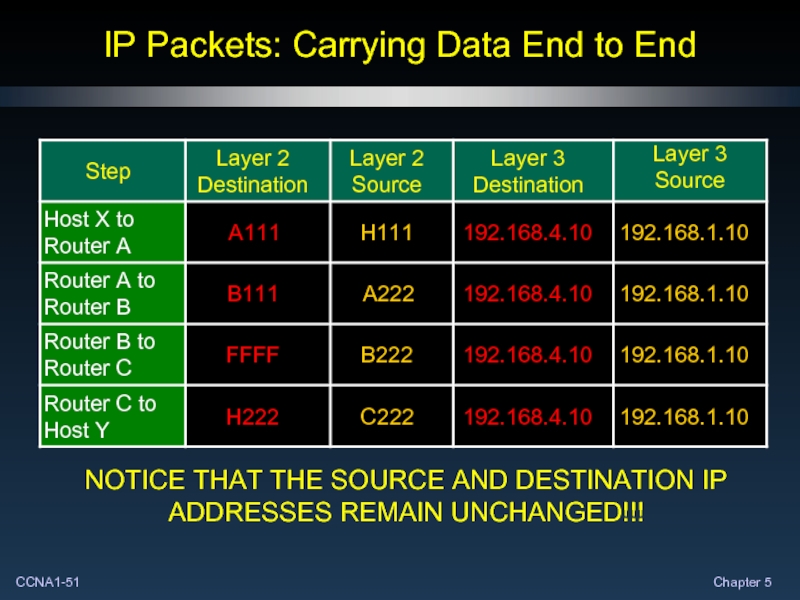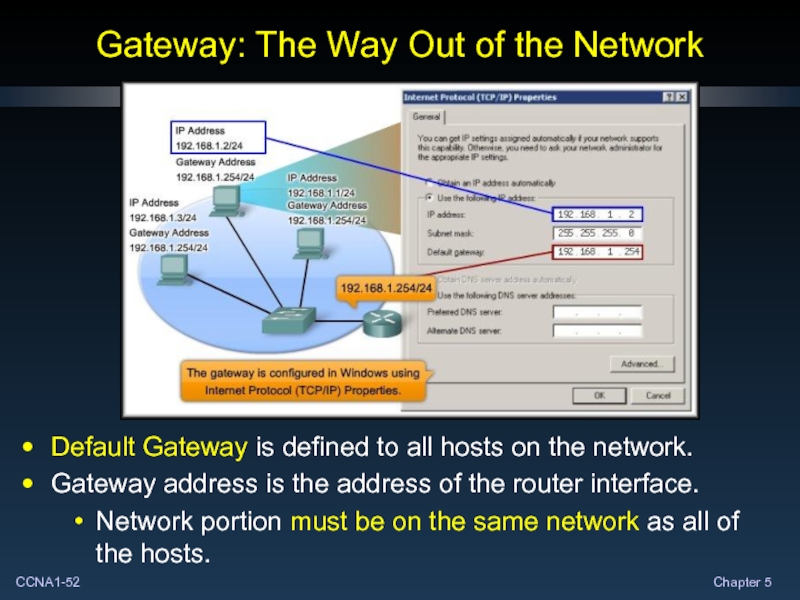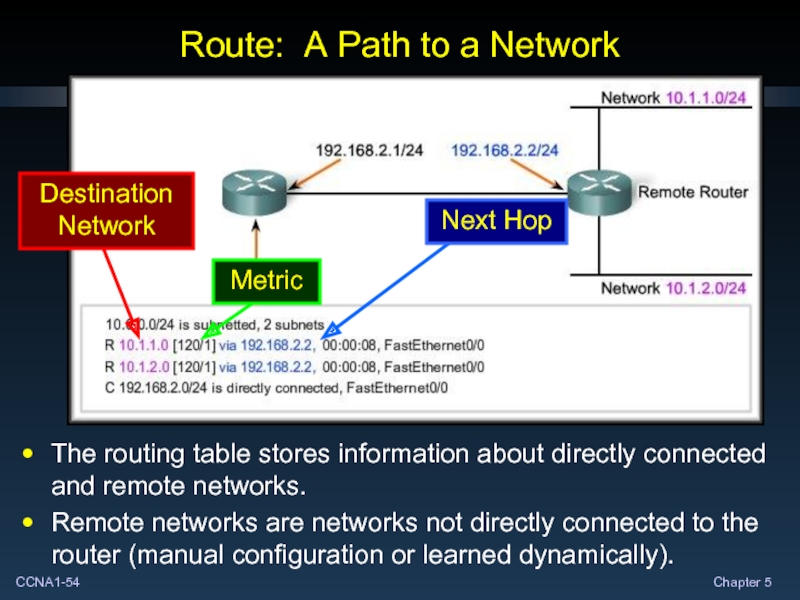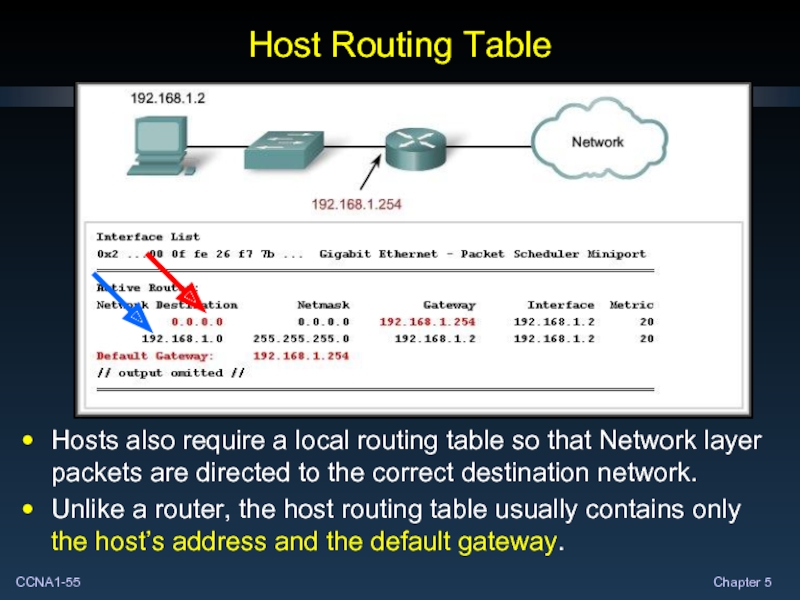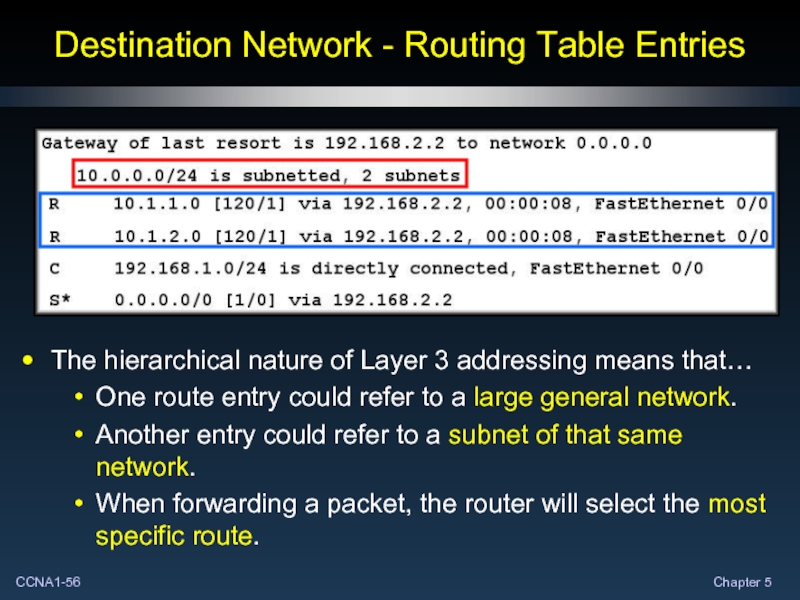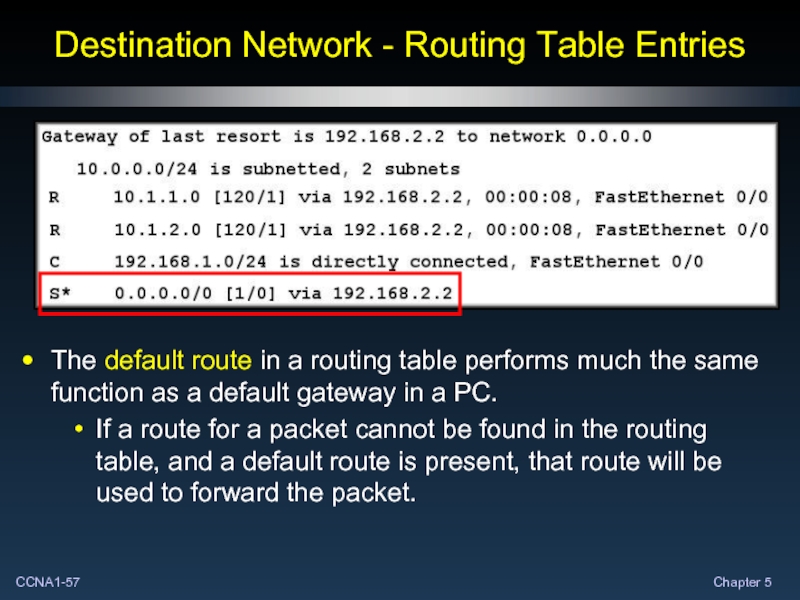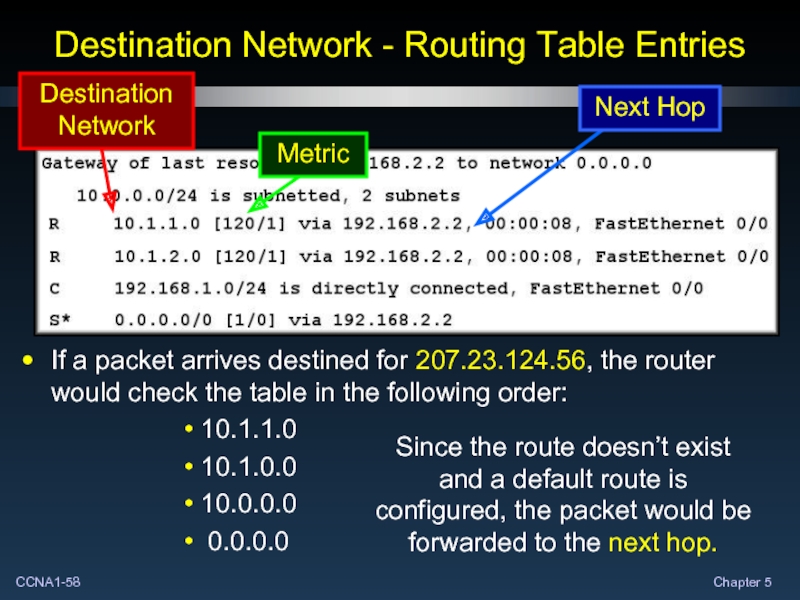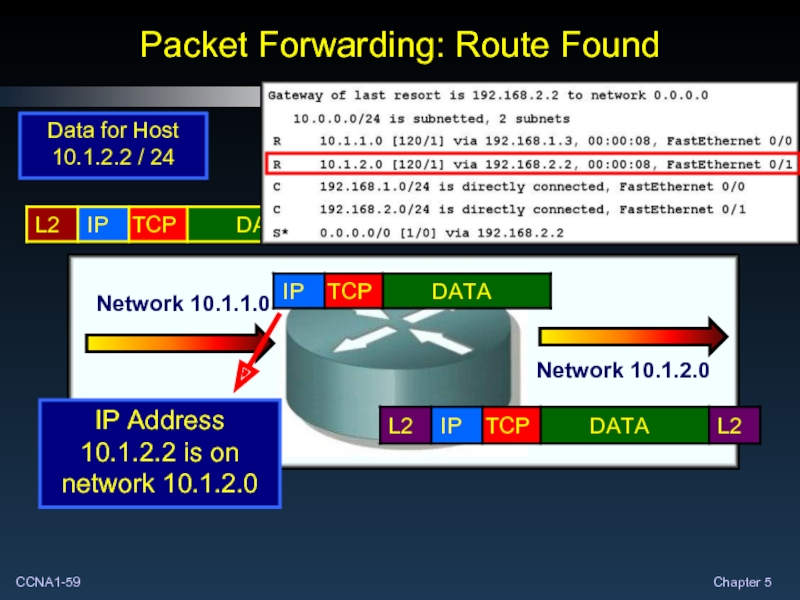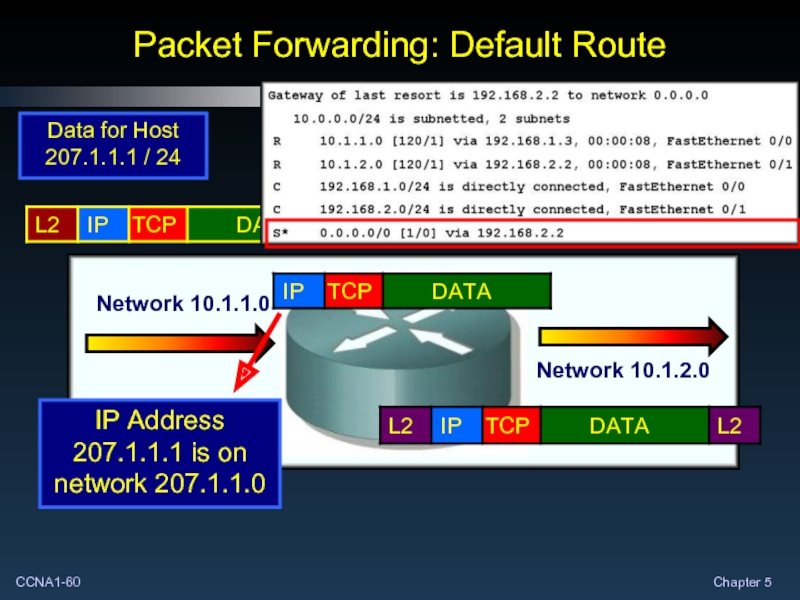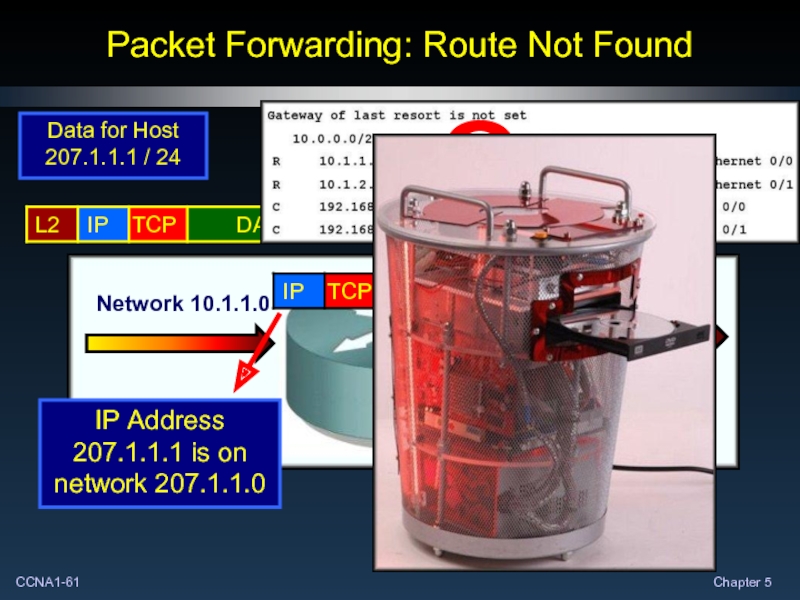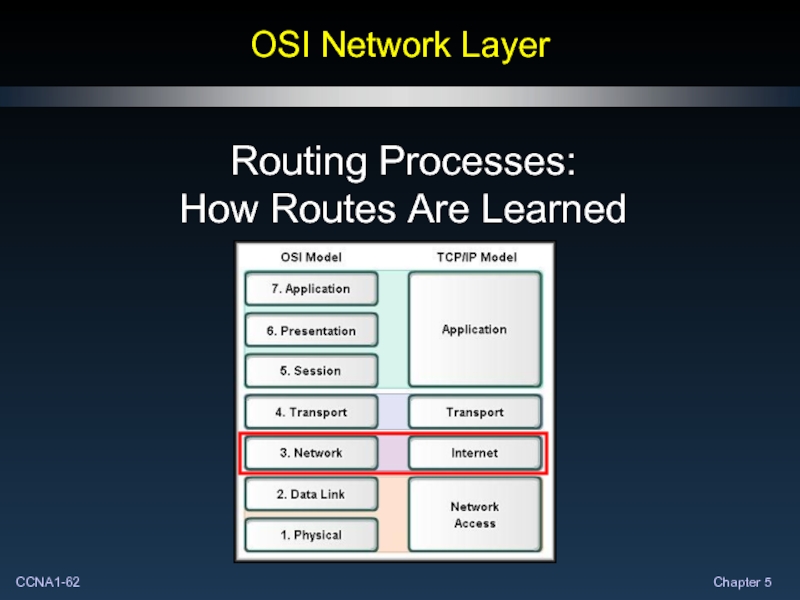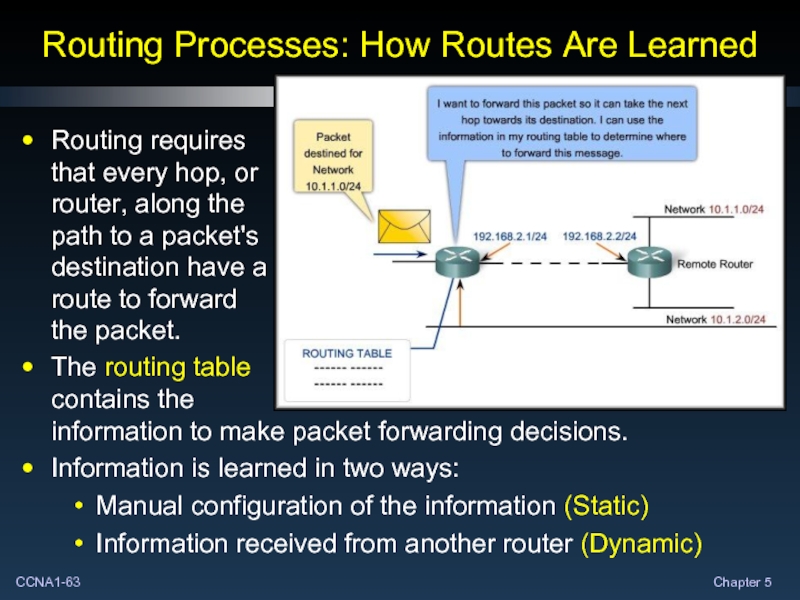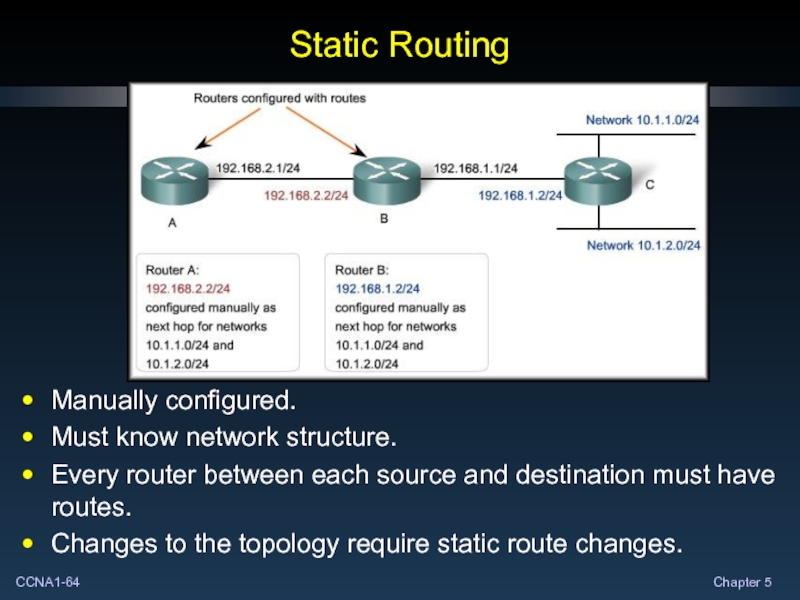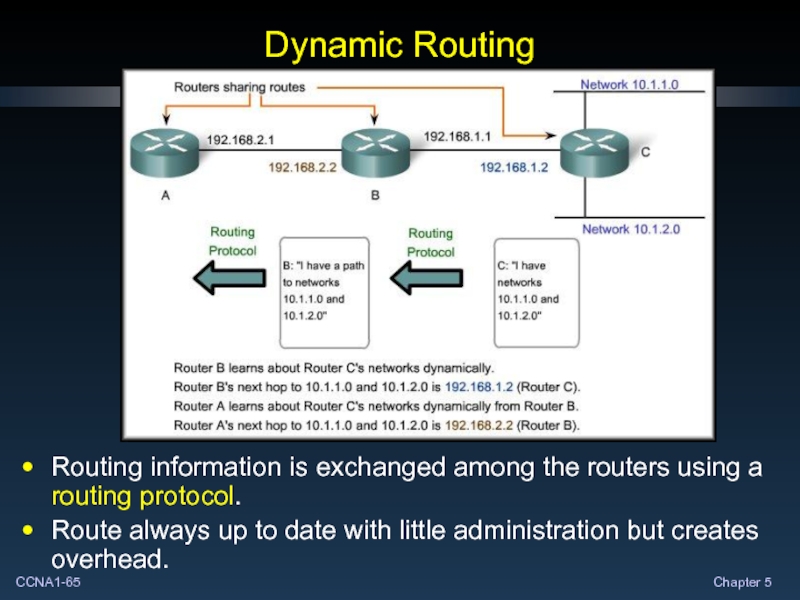- Главная
- Разное
- Дизайн
- Бизнес и предпринимательство
- Аналитика
- Образование
- Развлечения
- Красота и здоровье
- Финансы
- Государство
- Путешествия
- Спорт
- Недвижимость
- Армия
- Графика
- Культурология
- Еда и кулинария
- Лингвистика
- Английский язык
- Астрономия
- Алгебра
- Биология
- География
- Детские презентации
- Информатика
- История
- Литература
- Маркетинг
- Математика
- Медицина
- Менеджмент
- Музыка
- МХК
- Немецкий язык
- ОБЖ
- Обществознание
- Окружающий мир
- Педагогика
- Русский язык
- Технология
- Физика
- Философия
- Химия
- Шаблоны, картинки для презентаций
- Экология
- Экономика
- Юриспруденция
OSI Network Layer презентация
Содержание
- 1. OSI Network Layer
- 2. OSI Network Layer Internet Protocol Version 4 (IPV4)
- 3. Communication from Host to Host As we communicate…
- 4. Communication from Host to Host Addresses packets
- 5. Network Layer Protocols We will be focusing on IPV4.
- 6. IPV4: Example Network Layer Protocol Internet Protocol
- 7. IPV4: Example Network Layer Protocol Internet Protocol
- 8. IPV4: Example Network Layer Protocol Characteristics: Connectionless “Best Effort” Delivery (Unreliable) Media Independent
- 9. Connectionless
- 10. “Best Effort” Delivery (Unreliable) Unreliable means simply
- 11. Media Independent Not concerned with the physical
- 12. Media Independent Is concerned with the size
- 13. Media Independent Copper Ethernet: MTU = 1,518
- 14. Packaging the Transport Layer PDU
- 15. IPV4 Packet Header
- 16. OSI Network Layer Networks: Dividing Hosts into Groups
- 17. Dividing Hosts into Groups As networks grow,
- 18. Dividing Hosts into Groups Should it be divided geographically?
- 19. Dividing Hosts into Groups Should it be divided based on purpose?
- 20. Dividing Hosts into Groups Should it be divided based on ownership?
- 21. Why Separate Hosts into Networks? Performance Security Address Management
- 22. Performance Large numbers of hosts on a
- 23. Performance Routers block broadcasts unless specifically configured
- 24. Security
- 25. Address Management The role of the gateway….
- 26. Hierarchical Addressing 1 2 3 4 IP
- 27. Dividing Networks from Networks The IP Version
- 28. Dividing Networks from Networks
- 29. Dividing Networks from Networks An IP Version
- 30. Dividing Networks from Networks There is a
- 31. IP Addressing – The Subnet Mask There
- 32. IP Addressing – The Subnet Mask The
- 33. OSI Network Layer Routing: How Data Packets Are Handled
- 34. Address Types Two address types: MAC address:
- 35. Each Host Has Two Addresses Physical (MAC):
- 36. Each Host Has Two Addresses Logical (IP):
- 37. Host X sends a packet to Host
- 38. How does Host X know to forward
- 39. NOW what happens? IP Packets: Carrying Data
- 40. NOW what happens? IP Packets: Carrying Data
- 41. IP Packets: Carrying Data End to End
- 42. IP Packets: Carrying Data End to End
- 43. IP Packets: Carrying Data End to End
- 44. IP Packets: Carrying Data End to End
- 45. IP Packets: Carrying Data End to End
- 46. IP Packets: Carrying Data End to End
- 47. IP Packets: Carrying Data End to End
- 48. IP Packets: Carrying Data End to End
- 49. IP Packets: Carrying Data End to End
- 50. IP Packets: Carrying Data End to End
- 51. IP Packets: Carrying Data End to End
- 52. Gateway: The Way Out of the Network
- 53. Gateway: The Way Out of the Network
- 54. Route: A Path to a Network The
- 55. Host Routing Table Hosts also require a
- 56. Destination Network - Routing Table Entries The
- 57. Destination Network - Routing Table Entries The
- 58. Destination Network - Routing Table Entries If
- 59. Packet Forwarding: Route Found Data for
- 60. Packet Forwarding: Default Route Data for
- 61. Packet Forwarding: Route Not Found Data
- 62. OSI Network Layer Routing Processes: How Routes Are Learned
- 63. Routing Processes: How Routes Are Learned Routing
- 64. Static Routing Manually configured. Must know network
- 65. Dynamic Routing Routing information is exchanged among
- 66. Routing Protocols Routing Information Protocol (RIP) Enhanced
Слайд 4Communication from Host to Host
Addresses packets with an IP Address.
Encapsulates the
Routes the packet to the destination.
Decapsulates the packet.
Network
Layer
Слайд 6IPV4: Example Network Layer Protocol
Internet Protocol Version 4 (IPV4) is the
Only Layer 3 protocol used on the Internet.
Focus of this course.
Слайд 7IPV4: Example Network Layer Protocol
Internet Protocol Version 6 (IPV6) is developed
Will eventually replace IPV4.
Different characteristics than IPV4.
Слайд 8IPV4: Example Network Layer Protocol
Characteristics:
Connectionless
“Best Effort” Delivery (Unreliable)
Media Independent
Слайд 10“Best Effort” Delivery (Unreliable)
Unreliable means simply that IP does not have
Since protocols at other layers can manage reliability, IP is allowed to function very efficiently at the Network Layer.
Слайд 11Media Independent
Not concerned with the physical medium.
Operates independent of the layers
Слайд 12Media Independent
Is concerned with
the size of the
packet or
Maximum
Transmission
Unit (MTU).
The MTU is
Fragmentation:
At times, an intermediary device (router) will need to split up a packet when forwarding it from one media to a media with a smaller MTU.
Слайд 13Media Independent
Copper Ethernet: MTU = 1,518 bytes.
Copper Serial: Frame Relay MTU
Optical Fiber: ATM MTU = 17,966 bytes.
Wireless: 802.11 MTU = 2272 bytes.
Слайд 14Packaging the Transport Layer PDU
In TCP/IP based networks, the Network Layer
Слайд 17Dividing Hosts into Groups
As networks grow, they become too unwieldy to
Often, the solution is to divide the large network into several more manageable sub-networks.
The question is…..HOW?
Слайд 22Performance
Large numbers of
hosts on a single
network:
Actual Data
Overhead
A big part of the
overhead
In this context, each network is called a broadcast domain.
Switches forward broadcasts to each device connected to a switch port.
If we can reduce broadcast overhead, it would improve performance on the network.
Слайд 23Performance
Routers block
broadcasts unless
specifically
configured to
forward them.
Replacing the
switch in the
diagram with a
router, creates
Broadcasts are now contained within each network.
Слайд 26Hierarchical Addressing
1
2
3
4
IP Addresses are divided into a 2 level hierarchy –
Слайд 27Dividing Networks from Networks
The IP Version 4 Address contains elements that
An IP Address is like a telephone number:
519-972-2727
519 – Network Portion
972-2727 – Host Portion
519 – Windsor area
972-2727 - St. Clair College
Слайд 29Dividing Networks from Networks
An IP Version 4 address has two parts:
Network
Host number
The network portion of the address is the same for all hosts on the network.
Each device is identified by a unique host portion.
This hierarchy means that routers only need to know the network portion – not the address of each individual host.
Слайд 30Dividing Networks from Networks
There is a direct relationship, bit for bit,
Any subnet mask bit that is a 1 means that the associated address bit belongs to the network number.
Any subnet mask bit that is a 0 means that the associated address bit belongs to the host number.
Слайд 31IP Addressing – The Subnet Mask
There are two methods of expressing
The traditional method is to use the decimal value of the 1 bits that apply to the network.
192.168.1.2 255.255.255.0
This method is used for Classful Routing .
The new method is known as IP Prefix or CIDR.
Simply follow the IP address with a slash (/) and the number of bits that make up the network portion.
The remainder of the 32 bits are for the host number.
192.168.1.2 / 24
This method indicates Classless Routing or Classless Interdomain Routing (CIDR).
Слайд 32IP Addressing – The Subnet Mask
The network portion of the IP
All hosts on a segment have the same subnet mask.
Слайд 34Address Types
Two address types:
MAC address:
Physical address of the host
Burned in to
Layer 2 address
Network Address:
Logical address of the host
Assigned by network administrator
Layer 3 address
Слайд 35Each Host Has Two Addresses
Physical (MAC):
The physical address uniquely identifies the
This is the address that is absolutely necessary to get the information into the host. The IP address by itself won't accomplish that.
Слайд 36Each Host Has Two Addresses
Logical (IP):
The logical address uniquely identifies the
Routers base their decisions on the NETWORK PORTION of the IP address when determining the best path for the packet.
Слайд 37Host X sends a packet to Host Y.
A router generally relays
a path determination function – Routing
a switching function – Packet Forwarding
Let’s go through all of the stages these routers use to route and switch this packet.
IP Packets: Carrying Data End to End
Remember:
Two addresses are needed to move a packet from the source to the destination.
MAC Address
IP Address
Слайд 38How does Host X know to forward the packet to Router
IP Packets: Carrying Data End to End
Host X begins by encapsulating a packet with Host Y’s IP address and Router A’s MAC address.
How does HOST X obtain
Router A’s Layer 2 address?
Host X determines that the destination is NOT on the same network. (More Later)
The packet is forwarded to the default gateway.
Queries the router for the router’s MAC address (more later).
Слайд 39NOW what happens?
IP Packets: Carrying Data End to End
Router A receives
Router A uses the destination
IP address to search its routing table for network 192.168.4.0/24.
It finds that it has a next hop
address of 192.168.2.2 and an
exit port of fa0/1.
Слайд 40NOW what happens?
IP Packets: Carrying Data End to End
Router A knows
Router A looks in a table of IP address to MAC address for all connected networks. If the network isn’t there, it queries Router B for it’s MAC address.
Слайд 41IP Packets: Carrying Data End to End
Router A now has all
Router A now re-encapsulates the frame, changing the Layer 2 addresses and forwards (switches) the frame out port fa0/1.
Слайд 42IP Packets: Carrying Data End to End
Notice that the Layer 3
Also notice that the routing table was used to find:
The next hop Layer 3 address
The next hop Layer 2 address
The exit port to use to forward the frame.
Слайд 43IP Packets: Carrying Data End to End
Router B receives the packet.
NOW
Router B uses the destination
IP address to search its routing table for network 192.168.4.0/24.
It finds that it has a next hop
address of 192.168.3.2 and an
exit port of s0/1 – a serial interface.
Слайд 44IP Packets: Carrying Data End to End
Router B knows that the
NOW what happens?
Since the exit interface is a serial interface, NOT an Ethernet interface, Router B does not need the Layer 2 address for the next hop.
Remember, serial interfaces are
like a pipe – one way in
and one way out.
Слайд 45IP Packets: Carrying Data End to End
When the interface is a
Router B now encapsulates the IP packet into the proper data link frame, using the proper serial encapsulation (HDLC, PPP, etc.).
Слайд 46IP Packets: Carrying Data End to End
The destination Layer 2 address
The source Layer 2 address is set to the exit port of Router B – the source of the frame.
Finally, the frame is forwarded (switched) out port s0/1 on Router B.
Слайд 47IP Packets: Carrying Data End to End
Router C receives the frame
on
NOW what happens?
Router C uses the destination
IP address to search its routing table for network 192.168.4.0/24.
It finds that the network is a directly connected network with an exit interface of fa0/0.
Слайд 48IP Packets: Carrying Data End to End
Router C realizes that this
Since the exit interface is on an directly connected Ethernet network, Router C must obtain the destination’s MAC address.
Слайд 49IP Packets: Carrying Data End to End
Router C looks in a
If the entry was not in the table, Router C would need to send a query out fa0/0 that says, “What is the MAC address for this IP address?”
Host Y would send back a reply that says, “This is the MAC address that matches the IP Address you sent.”
Слайд 50IP Packets: Carrying Data End to End
Router C encapsulates the Ethernet
The source Layer 2 address becomes the MAC address of the router’s fa0/0 port.
The frame is forwarded (switched) out port fa0/0 to the destination host – Host Y.
Слайд 51IP Packets: Carrying Data End to End
NOTICE THAT THE SOURCE AND
Слайд 52Gateway: The Way Out of the Network
Default Gateway is defined to
Gateway address is the address of the router interface.
Network portion must be on the same network as all of the hosts.
Слайд 53Gateway: The Way Out of the Network
Additionally, no packet can be
A router makes a forwarding decision for each packet that arrives at the gateway interface.
The destination may be one or more hops away.
Слайд 54Route: A Path to a Network
The routing table stores information about
Remote networks are networks not directly connected to the router (manual configuration or learned dynamically).
Слайд 55Host Routing Table
Hosts also require a local routing table so that
Unlike a router, the host routing table usually contains only the host’s address and the default gateway.
Слайд 56Destination Network - Routing Table Entries
The hierarchical nature of Layer 3
One route entry could refer to a large general network.
Another entry could refer to a subnet of that same network.
When forwarding a packet, the router will select the most specific route.
Слайд 57Destination Network - Routing Table Entries
The default route in a routing
If a route for a packet cannot be found in the routing table, and a default route is present, that route will be used to forward the packet.
Слайд 58Destination Network - Routing Table Entries
If a packet arrives destined for
10.1.1.0
10.1.0.0
10.0.0.0
0.0.0.0
Since the route doesn’t exist and a default route is configured, the packet would be forwarded to the next hop.
Слайд 60Packet Forwarding: Default Route
Data for Host 207.1.1.1 / 24
Network 10.1.1.0
Network 10.1.2.0
Слайд 61Packet Forwarding: Route Not Found
Data for Host 207.1.1.1 / 24
Network 10.1.1.0
Network
?
Слайд 63Routing Processes: How Routes Are Learned
Routing requires
that every hop, or
router, along
The routing table contains the information to make packet forwarding decisions.
Information is learned in two ways:
Manual configuration of the information (Static)
Information received from another router (Dynamic)
Слайд 64Static Routing
Manually configured.
Must know network structure.
Every router between each source and
Changes to the topology require static route changes.
Слайд 65Dynamic Routing
Routing information is exchanged among the routers using a routing
Route always up to date with little administration but creates overhead.
